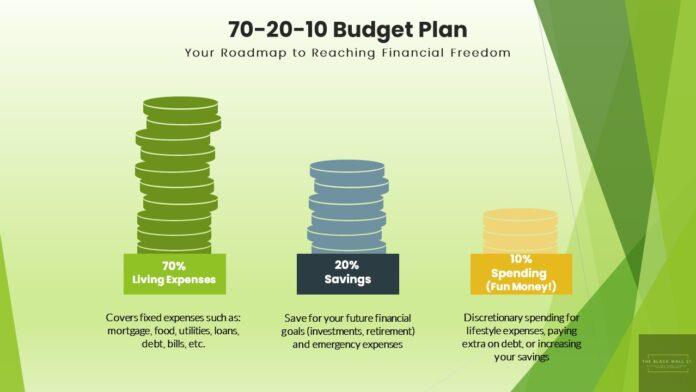LEARNING OBJECTIVES FROM THIS ARTICLE:
- What is the 70-20-10 budget plan?
- How does the plan work?
- How you can use the 70-20-10 budget plan to reach your goals.
Have you ever tried taking a road trip without a GPS? It’s risky, and you’re bound to get lost along the way. Well, trying to reach your financial goals without having a budget plan is the same as taking a road trip without a map – it’s way more difficult than it needs to be and you’re bound to run into unforeseen obstacles that you would’ve been prepared for otherwise.
This article will discuss the 70-20-10 budget plan and provide you with one of the many financial maps you can follow to reach your goals on your personal finance journey.
What Is the 70-20-10 Budget Plan?
A budget acts as your roadmap to reach your financial goals by making sure your money is allocated in a way that you cover financial obligations, save for the future, and enjoy living in the present.
The 70-20-10 budget plan is a simple way to separate your income into buckets, so you can track your cashflow (how much money you have coming in and out) and know where your money is going every month. The “70”, “20”, and “10” in the budget plan name represents the percentage amount of your income that should be allocated to each bucket. In this plan 70% of your income is allocated towards living expenses, 20% towards savings, and 10% for discretionary spending.
How does the 70-20-10 plan work?
The 70-20-10 budget plan works by having you track your month take-home pay and allocating it into three buckets: living expenses, savings, and discretionary spending. So, for example, if your monthly take-home income was $4,000, $2,800 would be allocated for your living expenses, $800 for savings, and $400 for discretionary spending. Besides knowing where your money is going and having a general idea of how much you should be spending in certain aspects of your life, the budget also serves as a tool to teach you to live within your means and avoid lifestyle creep.
Next, we’ll discuss the components of each category so that you’re budgeting your money appropriately.
Living Expenses – 70%
The Living Expenses Category covers all the necessities of life.
This category includes items such as:
- Mortgage/rent
- Groceries
- Utilities
- Phone
- Internet
- Transportation expenses (car note, car insurance, fuel, public transit)
- Clothing
- Haircut/salon
Certain fix expenses such as student loans, credit card debt, or other reoccurring bills are also considered “living expenses” because they are monthly expenses that you are obligated to pay.
Savings – 20%
The Savings Category is where you “pay yourself first”. This is the second most important category to fund in your budget because this is where you put your money to work so you can reach your short-term financial goals, invest in your future, and build a legacy that creates generational wealth.
The savings category includes savings goals such as:
- Building an emergency fund
- Retirement savings
- College savings
- Home down payment
In general, you will want to save up an emergency fund of 3 to 6 months of living expenses before moving onto longer-term financial goals. This task may sound daunting, but you can break this down into baby steps by first building a starter emergency fund of $1,000 – enough to cover any minor emergencies, such as a car repair or medical expense that may come up. In addition to building a starter emergency fund of $1,000, some general guidelines for allocating your money within this category include setting aside 10% for retirement, 5% for emergencies, and 5% for your other goals.
Discretionary Spending – 10%
The Discretionary Spending Category is for all your discretionary spending, i.e. all the money you have left over after paying for your living expenses and investing in your future. This category is the most flexible and can be a real game-changer for your financial future.
Some people like to consider the money in this category as strictly “fun money” – their treat to themselves for working hard, taking care of their responsibilities, and saving for their future. Others like to use this extra money for big financial goals or to pay down a debt faster. Many people use this money for both – a mixture of fun and extra savings for other goals.
Examples of items that fall under the spending category include:
- Dining out
- Vacations
- Gym membership
- Cable television/streaming services
The beauty of having a spending account is that you can be creative with the ways you use this money and still have the peace of mind that all your living expenses and savings goals have been met for the month.
How can you use the 70-20-10 plan to reach your financial goals?
Now that you know what a budget is and all its components, the next question you may have is “how can I use it to help me reach my financial goals?” Well, I’m glad you asked. By following a budget, you will be able to:
- Stay on top of your financial obligations.
- Track your expenses and make sure you’re not overspending where you shouldn’t be.
- Help you build an emergency fund.
- Make sure you’re saving an adequate amount of money to reach your long-term goals.
- Pay down debt by knowing where you can make cuts to your spending.
The benefits of creating a budget really are innumerable, but I think you get the picture. Having a budget (your roadmap) makes the rest of your financial journey fun, easy, and less risky.
One more note…
Maybe the 70-20-10 plan doesn’t work for your situation, that’s fine. Try adjusting the percentages to match your current financial situation. The most important lesson that you can take away from building a budget is the ability to create a plan for your financial future.















